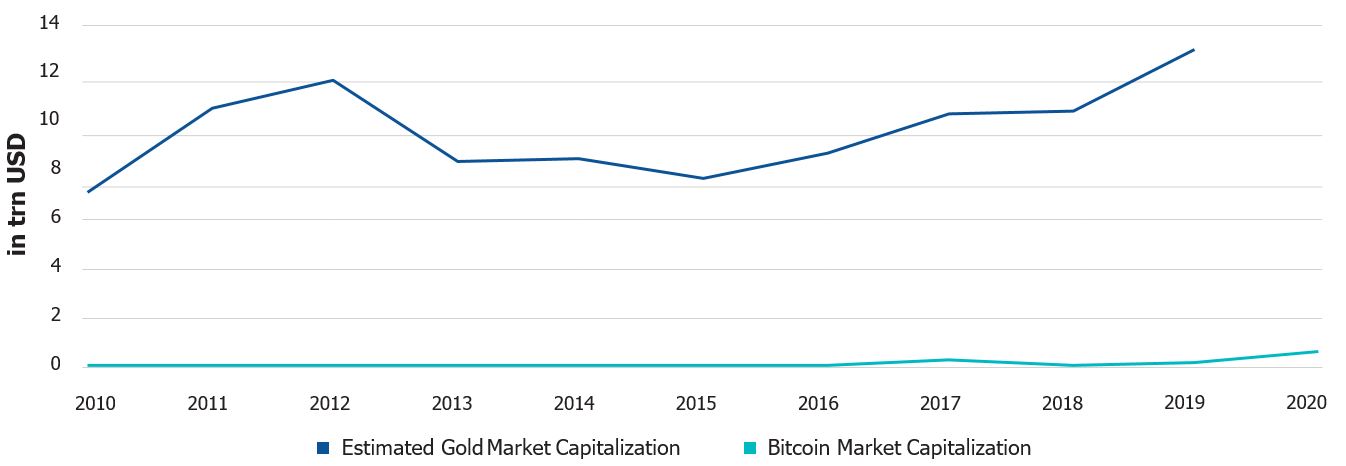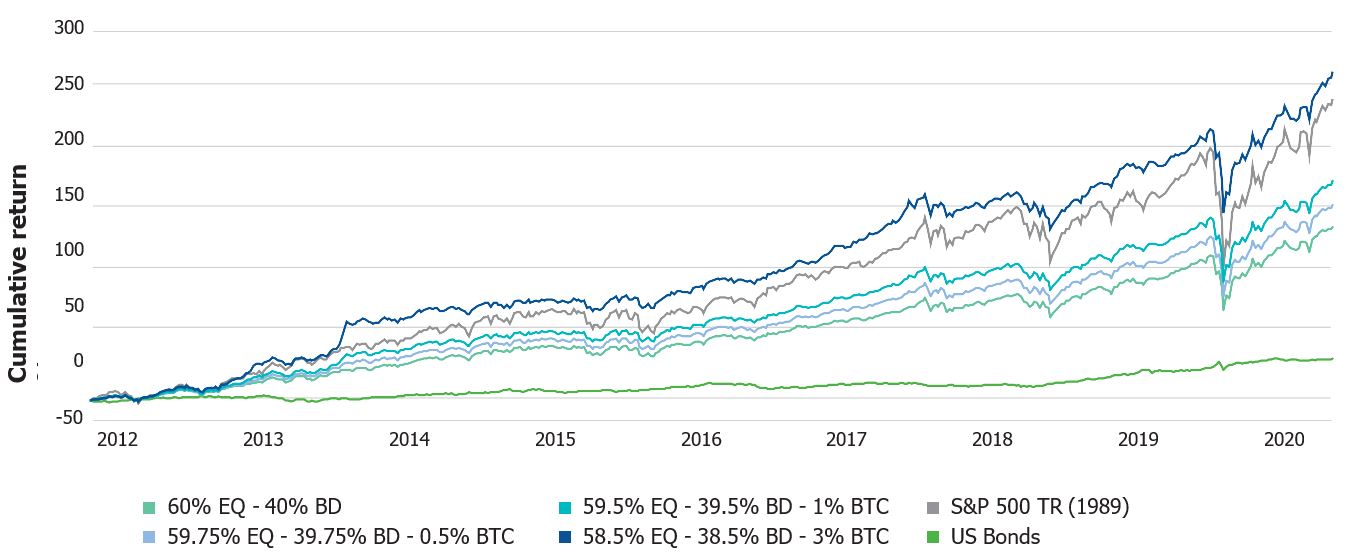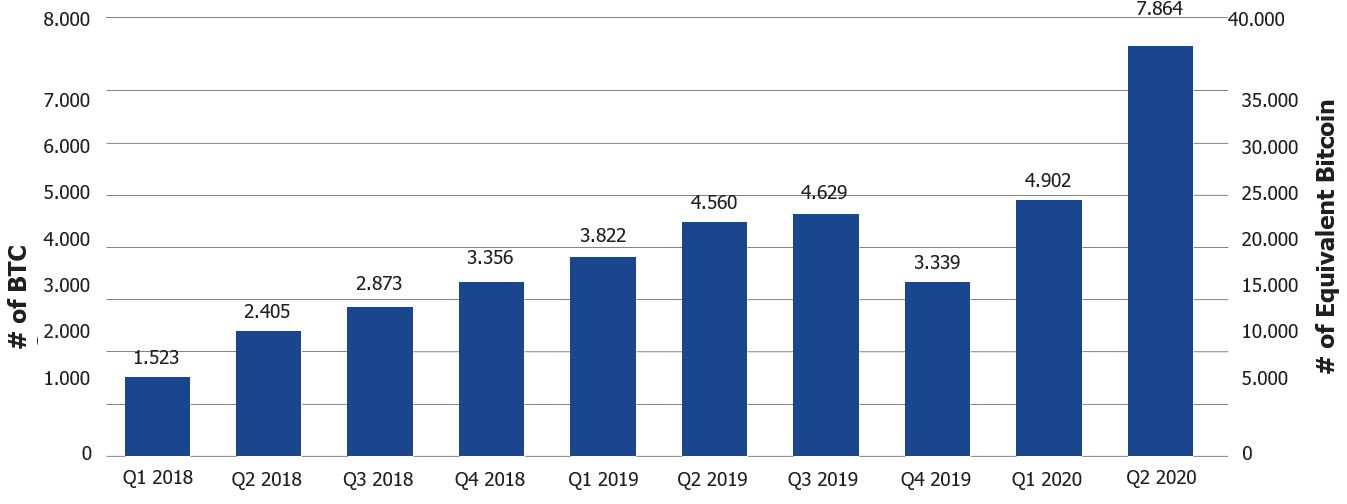Bitcoin’s Maturing Investment Case
27 January 2021
Bitcoin is gaining credence as a store of monetary value and acceptance as a way of diversifying investment portfolios. Innovations such as a new ETP are important stepping stones to making investment more practical.
In the second half of 2020, Bitcoin has won greater recognition as a form of digital gold – a digital store of value in an age of uncertainty. Between July and December, its price has more than tripled, from USD 9,100 per Bitcoin to 29,000 (as of 31 December 2020), with the greatest surge occurring in October and November. The reason? Growing institutional acceptance and the digital currency’s increasing accessibility.
In August, MicroStrategy, a US public company, invested its entire corporate treasury in Bitcoin. Then, in October, PayPal opened up its platform for buying and selling. These events followed the ‘halving’ of Bitcoin in May – the scheduled reduction of Bitcoin’s new supply that happens about every four years and tends to trigger price increases.
With the price surpassing its 2017 all-time high of USD 19,783, and greater acceptance in the financial ecosystem, 2020 has been a seminal year for Bitcoin. On top of these two events, VanEck launched the VanEck Bitcoin ETN in November, trading on Deutsche Boerse Xetra. One of the first fully-collateralized Bitcoin exchange traded notes (ETNs), and from an established global asset manager, the launch is an important stepping stone in the cryptocurrency’s development giving investors access to the total return of bitcoin in a proven and established format.
Since its founding in 1955, VanEck has established a reputation for thinking beyond the financial markets to identify the trends—including economic, technological, political and social—that we believe will fuel investable opportunities. We offer forward-looking, intelligently designed financial products that provide investors access to these opportunities. VanEck was one of the first U.S. asset managers to offer investors access to international markets and recognized early the transformative potential of gold investing, emerging markets and ETFs. Today, the firm has USD 64 billion in assets under management.1
Bitcoin as a potential store of value
2020’s events build on those from Bitcoin’s launch in 2009, suggesting that it is increasingly viewed as a digital form of gold. While its scale remains relatively small, at around USD 540 billion (as of 31 December 2020), Bitcoin’s capitalization has grown in comparison to gold’s, which has an estimated market capitalization of USD 12 trillion. This represents approximately 5% of gold's market capitalization.
There are two types of value – intrinsic value and monetary value. Unlike equities or real estate, Bitcoin does not have the cashflow or utility that underlies intrinsic value. But like gold, silver or art, it is increasingly recognized as having monetary value – value that arises out of a collective belief.
The more societies come to accept that an object has monetary value, the more likely the object is to have monetary value in the future. Societies have long needed stores of monetary value that have more flexibility than intrinsic stores of value.
Bitcoin versus Gold Market Capitalization (in trn USD)

Source: Blockchain.info, World Gold Council, Bitcoin market capitalization as of 31 December 2020, gold estimated market capitalization as of 31 December 2019.
New forms of monetary value are not often created. Types of art are a good example. Art has predominantly gained monetary value in the past few centuries. Perhaps an even better example is gold. Gold acquired monetary value because it is scarce, durable and relatively easy to mold into coins and bars. In a similar way to gold, Bitcoin has monetary value because it is scarce, durable and is a bearer asset which makes it appealing in authoritarian regimes.
Role in an investment portfolio
Just as Bitcoin is gaining credence for its monetary value, so too it is being thought of as an investment. Several theories exist as to why it may be an attractive investment, not least due to its continually increasing scarcity value. The architecture of the Bitcoin network means that its native currency (lower b bitcoin) will be issued in ever decreasing amounts, until the supply reaches 21 million, at which point all issuance will stop. This increasing stock-to-flow ratio – the amount of a commodity held in inventories, divided by the amount produced annually – puts Bitcoin currently on par with the stock-to-flow ratio of gold, an asset widely perceived to be a hedge against high inflation. Its stock-to-flow ratio will increase far beyond gold’s by the next halving of the block subsidy in 2024. By contrast, central banks have been increasing the money supply at unprecedented rates as they seek to promote growth. Simultaneously, global debt is expected to reach USD 277 trillion by the end of 2020, equivalent to 365% of GDP and USD 20 trillion higher than in 2019.2

Source: VanEck.
Bitcoin has outperformed traditional asset classes over most long-term periods. Over the five years to 30 September 2020, for example, the digital asset has risen by an annualized 122.1%, versus 14.1% for the S&P 500 Index of US equities and 10.5% for world equities. Even gold has underperformed bitcoin, posting an annualized return of 10.6%, as measured by the spot gold price.
Additionally, Bitcoin’s price movements have moved largely independent of major asset classes such as equities, bonds or gold – also described as having a low correlation.
This property makes it more valuable as a means of diversifying a broad investment portfolio. However, it is worth noting that in times of extreme market stress, such as crises, the correlation of Bitcoin’s price with other asset classes increases. All of this suggests that a small allocation to Bitcoin can improve the long-term performance of a diversified investment portfolio, typically with a 60% allocation to equities and 40% to bonds. Allocating 3% of such a portfolio to Bitcoin would result in an allocation of 58.5% equity, 38.5% bonds and 3% Bitcoin. Over the period from the beginning of 2012 to the end of September 2020, its annualized return would have been 14.77%, which compares with 9.75% for the standard 60/40 equity/bond portfolio.
Curiously, an addition of bitcoin – despite being viewed as a highly risky asset – to a traditional portfolio would have also lowered the standard deviation.
Asymmetric Return Profile (31 Jan 2012 – 31 Dec 2020)


Source: Morningstar. Data as of 31 December 2020. Performance measured in US Dollar. Past performance is no guarantee of future results.
That said, Bitcoin is not without risks. First among them is volatility. It’s increase in value has been punctuated by some sharp falls along the way. It must be noted though, that until November, Bitcoin has been less volatile than many S&P 500 constituents. Then there is the security of the technology. While it is accepted to be secure, there is always the possibility of trading platforms being hacked or Bitcoin’s encryption being compromised, especially given the developments in powerful quantum computing.
Accelerating adoption
Against this backdrop, Bitcoin has steadily become a part of the financial ecosystem. Most recently, there is MicroStrategy’s decision to invest its entire USD 425 million treasury in Bitcoin, as well as PayPal’s decision to allow customers to trade Bitcoin directly.
Beyond that, regulators are beginning to recognize Bitcoin, with for instance the state of Colorado exempting it from state securities regulation. Similarly, Liechtenstein was one of the first countries to regulate digital assets and Germany followed suit with an addition to the German Banking Act (“Kreditwesengesetz”) to cover crypto custody. In the European Union, MiCa (Markets in Crypto assets) has been developed to help regulate crypto assets and its service providers, so introducing a single licensing regime across all member states by 2024. Additionally, established custodians are entering the market, as are established brokerages.
Bitcoin volatility has decreased over time
90-day rolling volatility
Source: VanEck, data as of 31 December 2020, past performance is no guarantee of future performance.
Daily trading volume recently stood at USD 1.75 billion.4 The number of CME contracts reached a new record at the end of the second quarter of 2020, reaching 7,864 daily open interest, more than twice its level at the end of 2019. Recognizing Bitcoin’s incipient adoption as a store of monetary value, the endowment funds at both Harvard and Yale universities have invested in companies and venture capital funds that stand to benefit from its continuing emergence.
CME Bitcoin Futures Average Daily Open Interest

Source: CME Group. Data as of 30 June 2020.
A convenient way to get Bitcoin exposure
Even so, investing in Bitcoin has remained impractical. Buying and especially storing Bitcoin and other digital assets safely requires technical knowledge that may not be expected of the average user. In line with our commitment to support financial innovation, VanEck has brought a physically backed Bitcoin ETP to market. Trading on Deutsche Boerse Xetra, the VanEck Bitcoin ETN is as easy to buy and sell as other ETPs and requires nothing more but a brokerage account. Instead of buying Bitcoin on often unregulated exchanges and exposing the bearer asset to theft, hacks, security breaches and much more, the product can be traded on the regulated Deutsche Boerse exchange and be kept in safe custody by banks and brokers.
To promote safety and follow VanEck’s standards for transparent, client-friendly solutions, the product is fully-collateralized and 100% backed by Bitcoin. The bitcoin are kept in cold storage with a regulated custodian. Instead of safeguarding a Bitcoin’s private key themselves, investors can rely on the proven technical infrastructure of Bank Frick & Co. AG, a regulated financial institution and regulated crypto custodian under Liechtenstein law.
By replicating the price and yield performance of the MVIS CryptoCompare Bitcoin VWAP Close Index, the ETP investor is also eligible to receive returns from potential “hard forks” – changes to the underlying protocol that are not forward-compatible and result in two versions of the network. This has happened countless times in the past and investors tracking just the spot price of Bitcoin would have missed this portion of return. Two of the most well known hard-forks of Bitcoin are Bitcoin Cash and Bitcoin Gold. Bitcoin has evolved from a small cypher-punk experiment to the beginning of an entire new asset class, along the way changing the world’s perspective on expansive monetary policy and government interventions. This has happened at a time when many investors are seeing their return expectations from traditional saving vehicles/ asset classes dwindle as hidden inflation is slowly eroding their asset base.
Bitcoin provides a sensible alternative to these traditional asset classes by offering investors an uncorrelated stream of returns supported by a reliable, perfectly predictable disinflationary monetary base.
Learn more about Investing in Bitcoin
1Data as of 30 September 2020.
2Global Debt Monitor: Attack of the Debt Tsunami; Institute of International Finance, November 2020.
3Inception of the index on 31 January 2012.
4Cryptocompare. Data as of 31 December 2019.
Index Definitions
All indices are unmanaged and include the reinvestment of all returns but do not reflect the payment of transactions costs or expenses that are typically associated with digital assets portfolios. Indices were selected for illustrative purposes only and are not securities in which investments can be made. The returns of actual accounts investing in digital assets are likely to differ from the performance of each corresponding index. In addition, the returns of accounts will vary from the performance of the indices for a variety of reasons, including timing and individual account objectives and restrictions. Accordingly, there can be no assurance that the benefits and risk/return profile of the indices shown would be similar to those of actual accounts managed. Performance is shown for the stated time period only.
S&P® 500 Index: a float-adjusted, market-cap-weighted index of 500 leading U.S. companies from across all market sectors. The MVIS CryptoCompare Bitcoin VWAP Close Index measures the performance of a digital assets portfolio which invests in Bitcoin.
All S&P indices listed are products of S&P Dow Jones Indices LLC and/or its affiliates and has been licensed for use by Van Eck Associates Corporation. Copyright © 2018 S&P Dow Jones Indices LLC, a division of S&P Global, Inc., and/or its affiliates. All rights reserved. Redistribution or reproduction in whole or in part are prohibited without written permission of S&P Dow Jones Indices LLC. For more information on any of S&P Dow Jones Indices LLC’s indices please visit www.spdji.com. S&P® is a registered trademark of S&P Global and Dow Jones® is a registered trademark of Dow Jones Trademark Holdings LLC. Neither S&P Dow Jones Indices LLC, Dow Jones Trademark Holdings LLC, their affiliates nor their third party licensors make any representation or warranty, express or implied, as to the ability of any index to accurately represent the asset class or market sector that it purports to represent and neither S&P Dow Jones Indices LLC, Dow Jones Trademark Holdings LLC, their affiliates nor their third party licensors shall have any liability for any errors, omissions, or interruptions of any index or the data included therein.
MV Index Solutions (MVIS®) develops, monitors and markets the MVIS Indices, a focused selection of pure-play and investable indices designed to underlie financial products. They cover several asset classes including hard assets and the internal equity markets as well as fixed income markets. MVIS is the index business of VanEck, a U.S. based investment management firm. All investing is subject to risk, including the possible loss of the money you invest. As with any investment strategy, there is no guarantee that investment objectives will be met and investors may lose money. Diversification does not ensure a profit or protect against a loss in a declining market. Past performance is no guarantee of future results.
Important Disclosure
For informational and advertising purposes only.
This information originates from VanEck (Europe) GmbH, Kreuznacher Straße 30, 60486 Frankfurt am Main. It is intended only to provide general and preliminary information to investors and shall not be construed as investment, legal or tax advice. VanEck (Europe) GmbH and its associated and affiliated companies (together “VanEck”) assume no liability with regards to any investment, divestment or retention decision taken by the investor on the basis of this information. Views and opinions expressed are current as of the date of this information and are subject to change with market conditions. Certain statements contained herein may constitute projections, forecasts and other forward looking statements, which do not reflect actual results. VanEck makes no representation or warranty, express or implied regarding the advisability of investing in securities or digital assets generally or in the product mentioned in this information (the “Product”) or the ability of the underlying Index to track the performance of the relevant digital assets market.
The underlying Index is the exclusive property of MV Index Solutions GmbH, which has contracted with CryptoCompare Data Limited to maintain and calculate the Index. CryptoCompare Data Limited uses its best efforts to ensure that the Index is calculated correctly. Irrespective of its obligations towards the MV Index Solutions GmbH, CryptoCompare Data Limited has no obligation to point out errors in the Index to third parties.
Investing is subject to risk, including the possible loss of principal up to the entire invested amount. You must read the prospectus and KID before investing. No part of this material may be reproduced in any form, or referred to in any other publication, without express written permission of VanEck.
Investments into the Product bear the risk of loss up to the total loss.
© VanEck (Europe) GmbH.
Important Disclosure
This is a marketing communication. Please refer to the prospectus of the UCITS and to the KID before making any final investment decisions.
This information originates from VanEck (Europe) GmbH, which has been appointed as distributor of VanEck products in Europe by the Management Company VanEck Asset Management B.V., incorporated under Dutch law and registered with the Dutch Authority for the Financial Markets (AFM). VanEck (Europe) GmbH with registered address at Kreuznacher Str. 30, 60486 Frankfurt, Germany, is a financial services provider regulated by the Federal Financial Supervisory Authority in Germany (BaFin).
The information is intended only to provide general and preliminary information to investors and shall not be construed as investment, legal or tax advice VanEck (Europe) GmbH, VanEck Switzerland AG, VanEck Securities UK Limited and their associated and affiliated companies (together “VanEck”) assume no liability with regards to any investment, divestment or retention decision taken by the investor on the basis of this information. The views and opinions expressed are those of the author(s) but not necessarily those of VanEck. Opinions are current as of the publication date and are subject to change with market conditions. Certain statements contained herein may constitute projections, forecasts and other forward-looking statements, which do not reflect actual results. Information provided by third party sources is believed to be reliable and have not been independently verified for accuracy or completeness and cannot be guaranteed. Brokerage or transaction fees may apply.
All performance information is based on historical data and does not predict future returns. Investing is subject to risk, including the possible loss of principal.
No part of this material may be reproduced in any form, or referred to in any other publication, without express written permission of VanEck.
© VanEck (Europe) GmbH / VanEck Asset Management B.V.
Sign-up for our ETF newsletter
Related Insights
27 November 2024
27 November 2024
07 November 2024
05 November 2024




